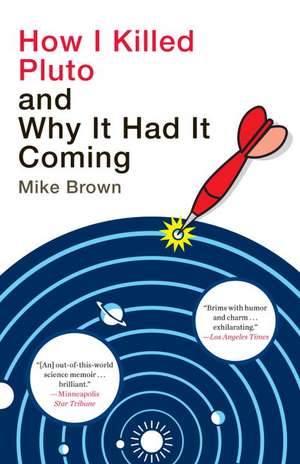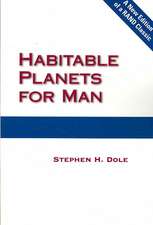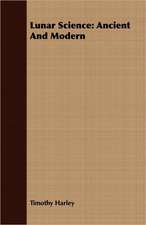How I Killed Pluto and Why It Had It Coming
Autor Mike Brownen Limba Engleză Paperback – 31 dec 2011
A heartfelt and personal journey filled with both humor and drama, How I Killed Pluto and Why It Had It Coming is the book for anyone, young or old, who has ever imagined exploring the universe—and who among us hasn’t?
Preț: 96.42 lei
Nou
Puncte Express: 145
Preț estimativ în valută:
18.45€ • 19.04$ • 15.62£
18.45€ • 19.04$ • 15.62£
Carte în stoc
Livrare din stoc 23 ianuarie
Preluare comenzi: 021 569.72.76
Specificații
ISBN-13: 9780385531108
ISBN-10: 0385531109
Pagini: 271
Ilustrații: 1 ILLUSTRATION
Dimensiuni: 132 x 203 x 15 mm
Greutate: 0.18 kg
Editura: Spiegel & Grau
ISBN-10: 0385531109
Pagini: 271
Ilustrații: 1 ILLUSTRATION
Dimensiuni: 132 x 203 x 15 mm
Greutate: 0.18 kg
Editura: Spiegel & Grau
Recenzii
“Brims with humor and charm . . . exhilarating.”—Los Angeles Times
“[An] out-of-this-world science memoir . . . brilliant . . . brings clarity and elegance to the complexities of planetary science. Brown is also a surprisingly self-effacing and entertaining genius.”—Minneapolis Star Tribune
“Brown’s brisk, enjoyable How I Killed Pluto and Why It Had It Coming chronicles the whole saga [of the demotion of Pluto] and, in the process, makes [its] sad fate easier to take. If we’ve lost a planet, we’ve gained a sprightly new voice for popular science.”—The Wall Street Journal
“Eminently readable and entertaining . . . blends elements of sleuthing, international intrigue, and the awe and wonder intrinsic to the exploration of space.”—The Oregonian
“An unlikely hybrid of Dennis Overbye’s Lonely Hearts of the Cosmos and Anne Lamott’s Operating Instructions.”—The New York Times Book Review
“[Brown] might be the finest scientist alive today. . . . We’re all better off for this man’s breathtaking commitment to science.”—The Boston Globe
“[An] out-of-this-world science memoir . . . brilliant . . . brings clarity and elegance to the complexities of planetary science. Brown is also a surprisingly self-effacing and entertaining genius.”—Minneapolis Star Tribune
“Brown’s brisk, enjoyable How I Killed Pluto and Why It Had It Coming chronicles the whole saga [of the demotion of Pluto] and, in the process, makes [its] sad fate easier to take. If we’ve lost a planet, we’ve gained a sprightly new voice for popular science.”—The Wall Street Journal
“Eminently readable and entertaining . . . blends elements of sleuthing, international intrigue, and the awe and wonder intrinsic to the exploration of space.”—The Oregonian
“An unlikely hybrid of Dennis Overbye’s Lonely Hearts of the Cosmos and Anne Lamott’s Operating Instructions.”—The New York Times Book Review
“[Brown] might be the finest scientist alive today. . . . We’re all better off for this man’s breathtaking commitment to science.”—The Boston Globe
Notă biografică
Mike Brown is the Richard and Barbara Rosenberg Professor of Planetary Astronomy at the California Institute of Technology. In 2006 he was named one of Time magazine’s 100 People Who Shape Our World as well as one of Los Angeles magazine’s Most Influential People in L.A. He lives in Southern California with his wife and daughter.
Extras
Chapter One
What Is a Planet?
One December night in 1999, a friend and I were sitting on a mountaintop east of San Diego inside a thirteen-story-tall dome. Only a few lights illuminated the uncluttered floor of the cavernous interior, but above you could vaguely see the bottom half of the massive Hale Telescope at Palomar Observatory. The Hale Telescope was, for almost fifty years, the largest telescope in the world, but from where we sat, with the weak yellow incandescent lighting being swallowed in the darkness above, you would never have guessed where you were. You might have thought you were deep in the interior of a pristine Hoover Dam, with cables and wire and pipes for directing the flow of water around. You might have believed that the steel structures around you were part of the far underground support and control of a spotlessly clean century-old subway system. Only when the entire building gently rumbled and a tiny sliver of the starry sky appeared far over your head and the telescope began to move soundlessly and swiftly to point to some new distant object in the universe, only then would you be able to make out the shadowy outline of the truss all the way to the top of the dome and realize that you were but a dot at the base of a giant machine whose only purpose was to gather the light from a single spot beyond the sky and focus it to a tiny point just over your head.
Usually when I am working at the telescope I sit in the warm, well-lit control room, looking at computer screens showing instrument readouts, staring at digital pictures just pulled from the sky, and pondering meteorological readings and forecasts for southern California. Sometimes, though, I like to step out into the cold, dark dome and stand at the very base of the telescope and look up at the sky through the tiny open sliver high overhead and see—with my own eyes—exactly what the giant machine is looking at. This December night, however, as I was sitting with my friend inside the dark dome, there was no sky to see. The dome was fastened closed, and the telescope was idle because the entire mountain was covered in cold, dripping fog.
I tend to get quite glum on nights when I’m at a telescope with the dome closed and the precious night is slipping past. An astronomer gets to use one of these biggest telescopes only a handful of nights per year. If the night is cloudy or rainy or snowy, too bad. Your night on the telescope is simply lost, and you get to try again next year. It’s hard not to think about lost time and lost discoveries as the second hand very slowly crawls through the night and your dome stays closed. Sabine—my friend—tried to cheer me up by asking about life and work, but it didn’t help. I instead told her about how my father had died that spring, and how I felt unable to really focus on my work. She finally asked me if there was anything that I was excited about these days. I paused for a few minutes. I momentarily forgot about the freezing fog and the closed dome and the ticking clock. “I think there’s another planet past Pluto,” I told her.
Another planet? Such a suggestion would have generally been scoffed at by most astronomers in the last days of the twentieth century. While it is true that for much of the last century astronomers had diligently searched for a mythical “Planet X” beyond Pluto, by about 1990 they had more or less convinced themselves that all that searching in the past had been in vain; Planet X simply did not exist. Astronomers were certain that they had a pretty good inventory of what the solar system contained, of all of the planets and their moons, and of most of the comets and asteroids that circled the sun. There were certainly small asteroids still to be discovered, and occasionally a bright comet that had never been seen before would come screaming in from the far depths of space, but certainly nothing major was left out there to find. Serious discussions by serious astronomers of another planet beyond Pluto were as likely as serious discussions by serious geologists on the location of the lost continent of Atlantis. What kind of an astronomer would sit underneath one of the biggest telescopes in the world and declare, “I think there’s another planet past Pluto”?
...
Almost a decade earlier, in the late summer of 1992, I was in the long middle years of my graduate studies at Berkeley (the place where I was taught that Planet X certainly did not exist and that we already knew pretty much everything we needed to know about what there was in the solar system). I didn’t think much about Planet X those days. I was midway through a Ph.D. dissertation about the planet Jupiter and its volcanic moon Io. When you’re midway through a Ph.D. dissertation, your mind acquires narrow blinders, so I didn’t think much about anything other than Io and how its volcanoes spewed material into space and affected Jupiter’s powerful magnetic field. I had so few thoughts to spare for most of the quotidian universe that I had fallen into a pattern of every day eating the same lunch at the same coffee shop right next to the Berkeley campus and having dinner at the same burrito stand a block away. At night I would ride my bicycle back down toward the San Francisco Bay to the marina where I lived on a tiny sailboat. The next morning I would start all over again. Less time thinking about what and where to eat and sleep meant more time thinking about Io and volcanoes and Jupiter and how they all fit together.
But, occasionally, even obsessive Ph.D. students need a break.
One afternoon, as on many times previous, after spending too much time staring at data on my computer screen and reading technical papers in dense journals and writing down thoughts and ideas in my black bound notebooks, I opened the door of my little graduate student office on the roof of the astronomy building, stepped into the enclosed rooftop courtyard, and climbed the metal stairs that went to the very top of the roof to an open balcony. As I stared at the San Francisco Bay laid out in front of me, trying to pull my head back down to the earth by watching the boats blowing across the water, Jane Luu, a friend and researcher in the astronomy department who had an office across the rooftop courtyard, clunked up the metal stairs and looked out across the water in the same direction I was staring. Softly and conspiratorially she said, “Nobody knows it yet, but we just found the Kuiper belt.”
I could tell that she knew she was onto something big, could sense her excitement, and I was flattered that here she was telling me this astounding information that no one else knew.
“Wow,” I said. “What’s the Kuiper belt?”
It’s funny today to think that I had no idea what she was talking about. Today if you sat next to me on an airplane and asked about the Kuiper belt, I might talk for hours about the region of space beyond Neptune where vast numbers of small icy objects circle the sun in cold storage and about how, occasionally, one of them comes plummeting into the inner part of the solar system to light up the skies like a comet. I might talk about the very edge of the solar system, where millions of little icy bodies never quite got gathered up into one big planet but instead stayed strewn in the disk surrounding the solar system. And I might tell you a little history, about how in the early 1990s no one had seen such a thing as this Kuiper belt, but a small group of astronomers who had predicted its existence had named the region the Kuiper belt after Dutch American astronomer Gerard Kuiper, who had speculated about its existence decades earlier. And finally, if you were still listening and the plane had not yet landed, I would tell you how this Kuiper belt was finally seen, for the first time, in the late summer of 1992, and how I first learned about it on the roof of the Berkeley astronomy building a day before it appeared on the front page of The New York Times.
But when Jane told me she had just found the Kuiper belt, I didn’t know any of this. Jane explained. She had not found this vast collection of bodies beyond Neptune, exactly, but simply a single small icy body circling the sun well beyond the orbit of Pluto. The body was tiny—much, much smaller than Pluto—and as far as anyone knew for sure, it might have circled the sun all alone at the edge of the solar system. But still, exciting, right?
Cute, I thought. But it’s just one tiny object, and it’s farther away than Pluto. How could that matter?
So I nodded and listened and, like any diligent Ph.D. student midway through a dissertation, eventually walked back down the stairs, stepped into my office, and reentered the world of Jupiter and Io and volcanoes, where I actually resided.
I was wrong, of course. Even though the object discovered was only a lonely, relatively tiny ball of ice orbiting beyond Pluto, it showed that astronomers had been wrong: They didn’t actually know everything; there were things still to be found at the edge of our own solar system. Some astronomers were reluctant to consider this new possibility seriously, and they dismissed the discovery as nothing more than a fluke that presaged absolutely nothing. But soon, as more and more astronomers became excited about the possibility of discovery and started searching the regions beyond Pluto, more and more of these small bodies began to be found.
By the end of 1999, on the foggy December night when Sabine and I were sitting underneath the Hale Telescope at Palomar Observatory and I was proclaiming that I thought there were new planets to be found, astronomers around the world had already discovered almost five hundred of these bodies in a vast disk beyond the orbit of Neptune in what looked very much indeed like the Kuiper belt. From being something that most astronomers had perhaps heard of once or twice, the Kuiper belt had become the hottest new field of study within the solar system.
Of the five hundred bodies that were then known in the Kuiper belt in 1999, most were relatively small, maybe a few hundred miles across, but a few moderately large objects had also been found. The largest known at the time was somewhere around a third the size of Pluto. A third the size of Pluto! Pluto had always enjoyed a somewhat mythical status as a lonely oddball at the edge of the solar system, but it turned out that it had more company than astronomers had originally thought.
Over the years since I had dismissed the entire Kuiper belt as not quite interesting enough to pull my mind away from Jupiter, I had actually been thinking a bit about Pluto and about those five hundred small icy bodies recently discovered in the distant solar system. By now it seemed to me inevitable that, whether anyone realized it or not, astronomers were on an unstoppable march that would eventually lead to a tenth planet. It seemed to me obvious that it was there, slowly circling the sun, just waiting for the moment when someone somewhere pointed a telescope at the right spot, noticed something that hadn’t been there earlier, and suddenly announced to an unsuspecting world that our solar system had more than nine planets.
From the Hardcover edition.
What Is a Planet?
One December night in 1999, a friend and I were sitting on a mountaintop east of San Diego inside a thirteen-story-tall dome. Only a few lights illuminated the uncluttered floor of the cavernous interior, but above you could vaguely see the bottom half of the massive Hale Telescope at Palomar Observatory. The Hale Telescope was, for almost fifty years, the largest telescope in the world, but from where we sat, with the weak yellow incandescent lighting being swallowed in the darkness above, you would never have guessed where you were. You might have thought you were deep in the interior of a pristine Hoover Dam, with cables and wire and pipes for directing the flow of water around. You might have believed that the steel structures around you were part of the far underground support and control of a spotlessly clean century-old subway system. Only when the entire building gently rumbled and a tiny sliver of the starry sky appeared far over your head and the telescope began to move soundlessly and swiftly to point to some new distant object in the universe, only then would you be able to make out the shadowy outline of the truss all the way to the top of the dome and realize that you were but a dot at the base of a giant machine whose only purpose was to gather the light from a single spot beyond the sky and focus it to a tiny point just over your head.
Usually when I am working at the telescope I sit in the warm, well-lit control room, looking at computer screens showing instrument readouts, staring at digital pictures just pulled from the sky, and pondering meteorological readings and forecasts for southern California. Sometimes, though, I like to step out into the cold, dark dome and stand at the very base of the telescope and look up at the sky through the tiny open sliver high overhead and see—with my own eyes—exactly what the giant machine is looking at. This December night, however, as I was sitting with my friend inside the dark dome, there was no sky to see. The dome was fastened closed, and the telescope was idle because the entire mountain was covered in cold, dripping fog.
I tend to get quite glum on nights when I’m at a telescope with the dome closed and the precious night is slipping past. An astronomer gets to use one of these biggest telescopes only a handful of nights per year. If the night is cloudy or rainy or snowy, too bad. Your night on the telescope is simply lost, and you get to try again next year. It’s hard not to think about lost time and lost discoveries as the second hand very slowly crawls through the night and your dome stays closed. Sabine—my friend—tried to cheer me up by asking about life and work, but it didn’t help. I instead told her about how my father had died that spring, and how I felt unable to really focus on my work. She finally asked me if there was anything that I was excited about these days. I paused for a few minutes. I momentarily forgot about the freezing fog and the closed dome and the ticking clock. “I think there’s another planet past Pluto,” I told her.
Another planet? Such a suggestion would have generally been scoffed at by most astronomers in the last days of the twentieth century. While it is true that for much of the last century astronomers had diligently searched for a mythical “Planet X” beyond Pluto, by about 1990 they had more or less convinced themselves that all that searching in the past had been in vain; Planet X simply did not exist. Astronomers were certain that they had a pretty good inventory of what the solar system contained, of all of the planets and their moons, and of most of the comets and asteroids that circled the sun. There were certainly small asteroids still to be discovered, and occasionally a bright comet that had never been seen before would come screaming in from the far depths of space, but certainly nothing major was left out there to find. Serious discussions by serious astronomers of another planet beyond Pluto were as likely as serious discussions by serious geologists on the location of the lost continent of Atlantis. What kind of an astronomer would sit underneath one of the biggest telescopes in the world and declare, “I think there’s another planet past Pluto”?
...
Almost a decade earlier, in the late summer of 1992, I was in the long middle years of my graduate studies at Berkeley (the place where I was taught that Planet X certainly did not exist and that we already knew pretty much everything we needed to know about what there was in the solar system). I didn’t think much about Planet X those days. I was midway through a Ph.D. dissertation about the planet Jupiter and its volcanic moon Io. When you’re midway through a Ph.D. dissertation, your mind acquires narrow blinders, so I didn’t think much about anything other than Io and how its volcanoes spewed material into space and affected Jupiter’s powerful magnetic field. I had so few thoughts to spare for most of the quotidian universe that I had fallen into a pattern of every day eating the same lunch at the same coffee shop right next to the Berkeley campus and having dinner at the same burrito stand a block away. At night I would ride my bicycle back down toward the San Francisco Bay to the marina where I lived on a tiny sailboat. The next morning I would start all over again. Less time thinking about what and where to eat and sleep meant more time thinking about Io and volcanoes and Jupiter and how they all fit together.
But, occasionally, even obsessive Ph.D. students need a break.
One afternoon, as on many times previous, after spending too much time staring at data on my computer screen and reading technical papers in dense journals and writing down thoughts and ideas in my black bound notebooks, I opened the door of my little graduate student office on the roof of the astronomy building, stepped into the enclosed rooftop courtyard, and climbed the metal stairs that went to the very top of the roof to an open balcony. As I stared at the San Francisco Bay laid out in front of me, trying to pull my head back down to the earth by watching the boats blowing across the water, Jane Luu, a friend and researcher in the astronomy department who had an office across the rooftop courtyard, clunked up the metal stairs and looked out across the water in the same direction I was staring. Softly and conspiratorially she said, “Nobody knows it yet, but we just found the Kuiper belt.”
I could tell that she knew she was onto something big, could sense her excitement, and I was flattered that here she was telling me this astounding information that no one else knew.
“Wow,” I said. “What’s the Kuiper belt?”
It’s funny today to think that I had no idea what she was talking about. Today if you sat next to me on an airplane and asked about the Kuiper belt, I might talk for hours about the region of space beyond Neptune where vast numbers of small icy objects circle the sun in cold storage and about how, occasionally, one of them comes plummeting into the inner part of the solar system to light up the skies like a comet. I might talk about the very edge of the solar system, where millions of little icy bodies never quite got gathered up into one big planet but instead stayed strewn in the disk surrounding the solar system. And I might tell you a little history, about how in the early 1990s no one had seen such a thing as this Kuiper belt, but a small group of astronomers who had predicted its existence had named the region the Kuiper belt after Dutch American astronomer Gerard Kuiper, who had speculated about its existence decades earlier. And finally, if you were still listening and the plane had not yet landed, I would tell you how this Kuiper belt was finally seen, for the first time, in the late summer of 1992, and how I first learned about it on the roof of the Berkeley astronomy building a day before it appeared on the front page of The New York Times.
But when Jane told me she had just found the Kuiper belt, I didn’t know any of this. Jane explained. She had not found this vast collection of bodies beyond Neptune, exactly, but simply a single small icy body circling the sun well beyond the orbit of Pluto. The body was tiny—much, much smaller than Pluto—and as far as anyone knew for sure, it might have circled the sun all alone at the edge of the solar system. But still, exciting, right?
Cute, I thought. But it’s just one tiny object, and it’s farther away than Pluto. How could that matter?
So I nodded and listened and, like any diligent Ph.D. student midway through a dissertation, eventually walked back down the stairs, stepped into my office, and reentered the world of Jupiter and Io and volcanoes, where I actually resided.
I was wrong, of course. Even though the object discovered was only a lonely, relatively tiny ball of ice orbiting beyond Pluto, it showed that astronomers had been wrong: They didn’t actually know everything; there were things still to be found at the edge of our own solar system. Some astronomers were reluctant to consider this new possibility seriously, and they dismissed the discovery as nothing more than a fluke that presaged absolutely nothing. But soon, as more and more astronomers became excited about the possibility of discovery and started searching the regions beyond Pluto, more and more of these small bodies began to be found.
By the end of 1999, on the foggy December night when Sabine and I were sitting underneath the Hale Telescope at Palomar Observatory and I was proclaiming that I thought there were new planets to be found, astronomers around the world had already discovered almost five hundred of these bodies in a vast disk beyond the orbit of Neptune in what looked very much indeed like the Kuiper belt. From being something that most astronomers had perhaps heard of once or twice, the Kuiper belt had become the hottest new field of study within the solar system.
Of the five hundred bodies that were then known in the Kuiper belt in 1999, most were relatively small, maybe a few hundred miles across, but a few moderately large objects had also been found. The largest known at the time was somewhere around a third the size of Pluto. A third the size of Pluto! Pluto had always enjoyed a somewhat mythical status as a lonely oddball at the edge of the solar system, but it turned out that it had more company than astronomers had originally thought.
Over the years since I had dismissed the entire Kuiper belt as not quite interesting enough to pull my mind away from Jupiter, I had actually been thinking a bit about Pluto and about those five hundred small icy bodies recently discovered in the distant solar system. By now it seemed to me inevitable that, whether anyone realized it or not, astronomers were on an unstoppable march that would eventually lead to a tenth planet. It seemed to me obvious that it was there, slowly circling the sun, just waiting for the moment when someone somewhere pointed a telescope at the right spot, noticed something that hadn’t been there earlier, and suddenly announced to an unsuspecting world that our solar system had more than nine planets.
From the Hardcover edition.
Descriere
In 2005, astronomer Brown made the discovery of a lifetime: a 10th planet, Eris, slightly bigger than Pluto. But instead of its resulting in one more planet being added to our solar system, Brown's find ignited a firestorm of controversy that riled the usually sedate world of astronomy and launched him into the public eye.












